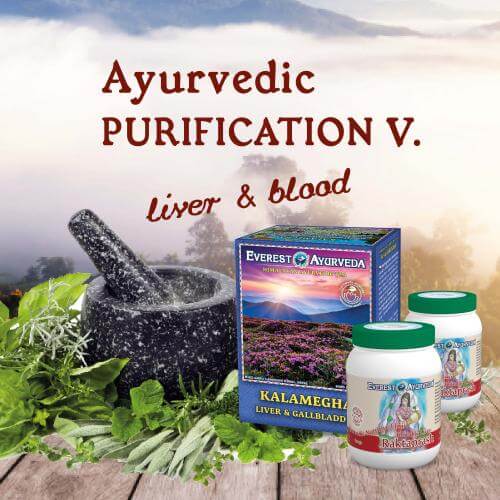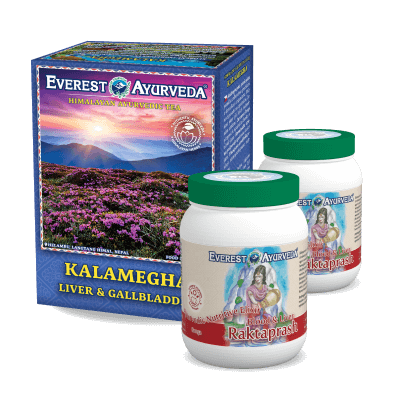
After the cold winter months comes the season of awakening spring, which according to Ayurveda is the ideal time for overall detoxification of the body. The liver is a key organ for spring detoxification and therefore deserves our attention. Let's get started with a spring liver cleanse!
In winter, the human body is naturally less active and requires more food. This results in a greater accumulation of ama, a waste substance that is insufficiently excreted and settles in the intestinal tract, liver and thus also enters the blood, which affects the health of the skin and other organs. Detoxification of the liver at this time is thus a natural process that will rid our body of heaviness, dullness and fatigue caused by the pollution of the body and also by the nature of the season, which is still dominated by kapha dosha made up of a combination of the earth and water elements.
Ayurvedic Significance of the Liver
The Sanskrit word for liver is jakrt, where "ja" means circulation and "krt" means activity or action. The liver is the primary and largest filtering organ of our body, which can purify and filter about 1.5 litres of blood per minute. The liver excretes bile as well as toxins from the body including heavy metals and bacteria. It takes care of metabolic processes such as digestion of fats, production of proteins, enzymes and cholesterol. In Ayurvedic terms, the liver is the organ that controls the pitta dosha composed of water and fire (agni). An increase in pitta dosha in the body, especially in people with this predominant characteristic, can then cause liver problems such as hepatitis, anemia, inflammation, chronic fatigue syndrome, mononucleosis, redness of the eyes and skin, acne, headaches, allergies, as well as anger and jealousy. However, even increased kapha dosha can cause high cholesterol in the liver, fatty liver, or diarrhea with fat in the stool (steatorrhea). Thus, here too, in addition to cleansing the liver, it is also necessary to keep one's natural doshic constitution in balance.
Find out your physical and mental constitution with a simple dosha test and follow the recommendations to maintain your health and balance!
Liver as the Seat of Emotions
The liver is an important seat of fire (agni) and in the case of increased pitta dosha it can also become the seat of inflammatory emotions such as anger, hostility, hatred and jealousy. If we experience these emotions and let them control or suppress them for a long time, our liver will suffer from an excess of heat and this can lead to liver and blood diseases. According to Ayurveda, which is the oldest science of healthy living and prevention, it is important to follow an appropriate diet and daily regimen based on the nature of our psychosomatic constitution. Thus, a person with a predominance of pitta dosha should take a moderate rather cooling diet and cultivate patience, calmness and detachment from sense objects in his life. Suppressed emotions often cause stress in the organs, which later leads to serious diseases. Read more in our article Stress and Negative Emotions - Consequences and Advices from an Ayurvedic Perspective.
What Helps the Liver?
Since the liver has no pain sensors, our body can function quite well for some time despite its considerable overload. An annual spring liver detox is an effective tool to prevent liver damage early and to nurture liver regeneration. This is also linked to other steps such as dietary modification, abstinence from alcohol and other addictive substances, regular exercise and sufficient rest. Ayurveda offers effective herbal formulas for detoxifying this key organ, which remove toxins from the body, reduce the overabundance of pitta dosha in the liver and generally promote its healthy functioning, improve blood quality and contribute to overall cleansing of the body. The Ayurvedic Health Therapy Liver & Blood Detox is also set in this spirit.
Liver & Blood Detox
This therapy includes Kalamegha tea, which helps to cleanse and detoxify the body. Thanks to the content of the eponymous herb kalamegha, turmeric and other Ayurvedic herbs with similar effects, it reduces hotness and thus contributes to optimal cleansing and healthy functioning of the liver. Terminalia arjuna supports proper liver function and Tinospora cordifolia strengthens the body's overall immunity.
The therapy includes 2 pcs of nutritional elixir Raktaprash for liver regeneration and overall restoration of healthy blood tissue. In addition to the herbs to support the liver, it contains the nutritional value of amalaki fruit rich in vitamin C, white sandalwood and turmeric, which purify the blood and contribute to good skin appearance, or Cinnamomum zeylanicum, which benefits cardiovascular function and normalizes blood glucose and cholesterol levels.
To make the Ayurvedic treatment work for you, take the recommended therapy for 3-4 weeks and follow the simple basic rules mentioned below.
Ayurvedic Detox Therapy
-
Duration: 3-4 weeks
-
Usage: 2 - 3 times a day
-
When: in the morning before breakfast, during the day 1h before or after meals and in the evening before bedtime
Dosage and Preparation of Ayurvedic Health Therapy
Always brew the herbal tea for 3-5 minutes, it is much more effective than simply infusing the herbal mixture with hot water. 1 teaspoon of the mixture is for 250 ml of water (one cup). However, you can brew a larger amount of tea for the whole day and keep it in thermos. Always drink the tea warm.
Just scoop the herbal elixir onto a teaspoon and eat it. Take 1 teaspoon 2 - 3 times a day with the Ayurvedic tea. It is always good to take the elixir with a tea, it is better absorbed this way. You can also take it with warm water or plant milk. Cow's milk is not recommended for cleansing, unlike revitalizing and regenerating treatments.
Recommended Regime During the Cleansing Therapy
The cleansing process in the body is of course helped by movement, which itself has natural detoxifying effects. It benefits a faster metabolism, where the intestines are emptied more easily.
It promotes perspiration and the elimination of harmful waste products from the body and oxygenates all cells, which can better receive the necessary nutrients, but also prana - one of the three life energies (the other two are tejas and ojas), which maintains the vital functions of the body such as breathing, cardiovascular system and brain activity.
The most important time of day for targeted cleansing is the morning. Here are 3 basic steps to follow upon waking:
- Empty yourself and take a shower (the body excretes waste substances through the skin overnight).
- Drink a glass of warm water with lemon juice and do a breathing exercise for 5 minutes to give your mind calm and positive energy: breathe very slowly and quietly - so that if someone put a thin thread in front of your nose, it wouldn't move. And when you breathe out, try to breathe out even more slowly than you breathed in.
- Drink a cup of cleansing Ayurvedic tea along with a teaspoon of herbal elixir (wait at least 30 minutes before having breakfast to allow the herbal preparations to be well absorbed).
At the same time, we recommend light jogging or fast walking at least 3 times a week. Go to bed before midnight.
Diet During Detox
For the duration of the detox therapy, leave out meaty and dairy foods from your diet. If you are used to them, try to significantly reduce their consumption - this alone will be a relief for the body. Also try to limit your intake of chocolate, biscuits and sweets containing white sugar. Replace these snacks with fresh or dried fruit without preservatives, unsalted nuts and fresh vegetables. Also keep a sufficient supply of clean water and avoid coffee, alcohol, stimulants and sugary sodas.
The cleansing process may bring with it temporary accompanying symptoms such as headache, tiredness and heaviness of the limbs. The uncomfortable feeling is associated with the elimination of toxins out of the body. However, if you persevere, the detox along with exercise and a light fresh diet will bring you more energy and stronger health.

